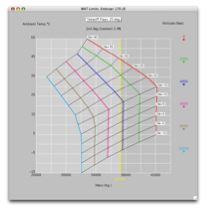Home | Back to Features | Next (Studies & Optimisation)
 The Takeoff Field Length (TOFL) and Landing Field Length (LFL) are calculated from first principles, based on FAR-25 definitions and using the appropriate aerodynamics and engine characteristics.
The Takeoff Field Length (TOFL) and Landing Field Length (LFL) are calculated from first principles, based on FAR-25 definitions and using the appropriate aerodynamics and engine characteristics. The user can control various parameters such as the braking friction coefficient and the takeoff safety speed ratio (V2/Vs, 1.2 by default). It is also possible to adjust the CLmax (max. Lift Coefficient) and Lift/Drag ratio at these low-speed conditions, as these aerodynamic parameters often cannot be known accurately without wind-tunnel or flight tests. Takeoffs can be conducted at ISA (International Standard Atmosphere) or off-ISA conditions and arbitrary field elevations.
The user can control various parameters such as the braking friction coefficient and the takeoff safety speed ratio (V2/Vs, 1.2 by default). It is also possible to adjust the CLmax (max. Lift Coefficient) and Lift/Drag ratio at these low-speed conditions, as these aerodynamic parameters often cannot be known accurately without wind-tunnel or flight tests. Takeoffs can be conducted at ISA (International Standard Atmosphere) or off-ISA conditions and arbitrary field elevations.
TAKEOFF PERFORMANCE {37200.kg., altitude 0.feet, ISA+0.deg.C.}
___________________
JAR25 Takeoff Field Length 5638. feet
115% Factored All-Eng.Dist. 5159. feet
Balanced Field Length 5638. feet
2nd Segment Climb Gradient 4.02 %
Takeoff CLmax 2.31 {trapezoidal ref.area}
Takeoff Vstall 117. keas
Takeoff Vmc 81. keas
Takeoff Vfail 133. keas
Takeoff V2 141. keas
L/D at 2nd segment 10.43 {incl.windmill & asymm.}
Takeoff Wing Loading 108. p.s.f.{trap.W/S}
Takeoff Thrust/Weight 0.335 available static
LANDING PERFORMANCE {32800.kg., altitude 0.feet, ISA+0.deg.C.}
___________________
JAR25 Landing Field Length 4331. feet
Landing Distance (LFL*0.6) 2598. feet
Landing Ground Roll 1546. feet
Landing CLmax 3.09 {trapezoidal ref.area}
Landing Vstall 95. keas
Approach Speed 124. keas
Approach L/D 5.32 {gear down}
|